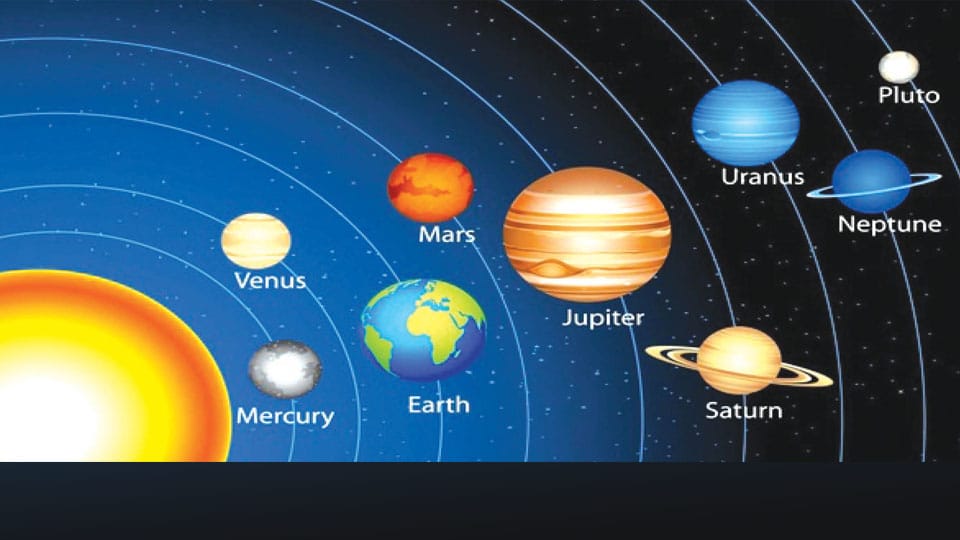Six planets galore in the evening sky at greater heights
By Dr. S.A. Mohan Krishna, Amateur Astronomer
Planet Watching’ is one of the most enthralling, pleasurable and spellbinding experience. If we witness the sky on a dark, clear night we can see many hundreds of stars and few terrestrial planets. They are not alike; they are of different colours, and of course they differ in brightness. Planets move slowly among the stars, following patterns that repeat over months or years. In September and October, Indians are privileged to witness six mesmerizing planets namely Mercury, Mars, Jupiter, Saturn, Uranus and Neptune — to fall in line forming a natural planetary conjunction.
This is a magnificent astronomical spectacle for amateur astronomers, astronomy connoisseurs and general public. The innermost planet of the solar system is ‘Mercury.’ As the Solar System’s innermost planet, its orbit keeps close to the Sun, the planet is visible only shortly before or briefly after sunset. It is clearly perceptible as a magnitude star at approximately two-monthly intervals alternating between evening and morning twilight. It looks like a warm-white star, and binoculars often help us to spot it. Spotting Mercury means searching evening sky for a dot of light. Presently, it can be seen at around 7 pm (IST) immediately after sunset and is also regarded as ‘Hostile Planet.’ It is well-placed for viewing over the western horizon after sunset for northern hemisphere observing. In a telescope Mercury’s apparent size and brightness vary according to its distance from Earth and place in orbit, with the planet showing phases like Moon.
‘Venus’ is second major planet in order of distance from the Sun. Even novice stargazers will have no difficulty finding brilliant Venus, often called the ‘morning’ or ‘evening’ star. Venus can be the brightest object in the sky after the Sun and Moon and allows a near-circular path some 106 million kilometres from the Sun, taking 225 days to complete one orbit. The most dazzling planet of solar system, Venus will be presently visible over the eastern direction before sunrise, and remains visible over the western horizon throughout the month. It can be clearly seen at 5 am (IST) in ‘Taurus’ constellation. In a telescope, Venus’ opaque clouds usually appear featureless. Sometimes, however, observers are able to make out faint, dark patches on the white disk, probably the cloud features.
‘Mars’ is the resplendent yellow-orange planet in the solar system. Look for Mars to be high over the southeast direction at 10 pm. During night, we can clearly see the red planet and can be effortlessly noticed through naked eyes, provided the night sky is absolutely clear. Mars can appear at any place in the sky on the ecliptic, rather than always staying near the Sun, like Mercury and Venus. Mars appears no larger than a lunar crater. Typical first looks show an amber disk, some faint markings, and may be a whitish polar cap. Mars is having close encounter with Earth on Oct. 13. In the closer proximity of Mars, one can notice Uranus and Neptune. Presently, Uranus can be seen through a 10-inch Dobsonian telescope easily. But, if we wish to see to Neptune, require at least a 14-inch high resolution astronomical telescope.
Jupiter is the second brightest planet after Venus. A few weeks before and after the opposition on July 2020, Jupiter was extraordinarily bright, reaching a visual magnitude of about -2.5 to – 2.6. This was an excellent opportunity to observe Jupiter, its Great Red Spot and Jupiter’s four largest satellites namely Io, Europa, Ganymede and Callisto. These celebrated satellites of Jupiter can be seen in a binocular also. A telescope with a magnification of 40 times or above is preferred in observing Jupiter. The apparent magnitude or brightness factor of Jupiter during July and August is – 2.6. Note that, the negative sign convention indicates that, the brightness will be maximum and for the positive sign convention, the brightness will be minimum. For example, the magnitude of full moon will be about — 12 and it depicts exceedingly good resplendence.
In July, Jupiter came closer to our beloved mother planet Earth for the entire year, and Jupiter blazes most brightly in our sky, outshining the night’s brightest stars by leaps and bounds. On July 14, Earth in its orbit swings between the Sun and Jupiter, an event that’s referred to as ‘Opposition of Jupiter.’ From Mysuru, Jupiter will be perceptible between 7 pm and 6 am. It reached the highest point or pinnacle in the sky at around midnight local time. Jupiter can be seen in the vicinity of the constellations ‘Capricornus’ and ‘Sagittarius’.Even today Jupiter is exhibiting its unprecedented glamour and grandeur.
Analogously, on July 20, Saturn had rendezvous with Earth and shall be the right time to witness this gorgeous ringed planet. ‘Saturn’ is the sixth planet from the Sun and the outermost planet perfectly noticeable with the unaided eye. Saturn’s rings are well-known and were explored in great detail by the Voyager and Cassini missions. Saturn’s rings has unmitigated, disc-like, effortlessly conspicuous with even a small telescope, which envelops Saturn. Saturn reached “opposition” on July 20, 2020 and so it has its best visibility this month. The specialty of this astronomical happening is that, the planet Saturn becomes more beautiful, also the best time to witness the planet. On that day, the planet will be closer to earth. Throughout the night Saturn is discernible and more resplendent. From Mysuru, Saturn will be perceptible between 7.30 pm and 6 am. It reaches the highest point or pinnacle in the sky at around midnight local time. Saturn can be seen in the vicinity of the constellations ‘Capricornus’ and ‘Sagittarius’. Saturn appears cream-white in colour and is among the brightest star-like objects in our sky this winter. Jupiter and Saturn have planned to dominate this year captivatingly! But in between Jupiter and Saturn, there is Pluto and could be noticed through a high resolution telescope.
Enjoy watching these six staggering planets in September and October. Other than Mercury and Neptune, other planets can be seen through naked eyes avoiding the sophistication. Telescopes for planet watching need sturdy mountings and high-quality optics. Most observers use powers of 200x or less, due to unsettled seeing. Also useful are coloured filters, which accentuate specific features on planets.








Recent Comments